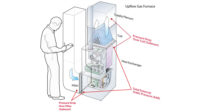Technicians must often make a decision about the best course of action to take for a repair. Choosing the right course of action is the key to a successful and profitable repair. Choosing the wrong course of action can lead to a problematic repair, loss of income, and a blemish on their reputation. Managing these risks is part of the job for every service technician.
A common example of this is when dealing with refrigerant leaks. On some fractional horsepower systems, finding the source of a leak can be difficult and time-consuming. One option is to simply add refrigerant to the system and hope the leak is small enough that the system continues to run adequately for a sufficient amount of time. Not a very good option, because the system may only operate a brief amount of time before it fails again. Another option is to add a sealant with the refrigerant and hope it seals the leak. This option may work, but it also may not work. The best option is to conduct a leak search to find and repair the leak. This option can be more costly and time-consuming, but if done correctly, the leak is assuredly repaired.
If a refrigerant leak is discovered in a coil, should the coil be repaired or replaced? Generally, it is cheaper for the customer and faster for the technician to repair the coil, but there is a definite risk to this approach. If the repair does not hold up — and many times it will not — the time and materials used are wasted, and the coil will have to be replaced anyway. So the safer approach, with lesser risk, is to replace the coil. In both of these scenarios, technicians are faced with a risk-versus-reward decision: attempt to save the customer money, or take the safest course of action and properly repair the leak.
During a major repair, there are times when technicians can save the customer some money by reusing some of the original components. For example, when replacing a compressor, it is best to also replace the compressor’s contactor and its starting components. However, these components may still be in workable condition, so perhaps they can be reused. Probably not a wise decision, but again, another risk-versus-reward decision.
There are several factors to consider when making a choice on the best course for a repair, one of which is the cost of returning to make the same or additional repairs. Again, using the refrigerant leak scenario, the cost of having to once again recover the refrigerant, repair or replace the leaking component, evacuate the system, and add the refrigerant back into the system should all factor in to the most appropriate course of action to take.
Also, when faced with these decisions, it is helpful to discuss the options with the supervisor and equipment owner. There may be unknown factors that could help determine the better choice for the repair. For example, the owner may be planning on repairing the system in the near future and would rather take the less expensive option in the repair.
Lastly, always attempt to make the repair recommendation that is best for the customer, and remember to treat the customer the way you would want to be treated if you owned the equipment.
Want to read more? See more articles from this issue here!









